
WG Moss published his “The History and Antiquities of the Town and Port of Hastings” in 1824. The actual production itself was interesting because it appeared in three distinct physical sizes, small medium and large - all using the same letterpress blocks and engravings but with varying margins to suit the dimensions of the book. As was customary at the time the engravings were printed by a specialist printer and married to the letterpress text by the bookbinder. In this case the book was printed by W Lewis, Finch Lane Cornhill and the engravings by R Miller. According to a contemporary advertisement, the whole was available as two volumes but.all three of my copies, (I have one of each size), are bound as single volumes and I am unaware of any other form of binding. The prints in the more expensive editions of the book used the Chine Appliqué the process where the engraved illustration was applied to a sheet of very fine bamboo paper which was itself embedded in the normal heavier gauge paper ant the time of printing, resulting in a much sharper image. In the cheaper editions the block was printed directly onto the heavier gauge paper. This separation in the printing process often explains why loose prints appear on the market and aren’t always obtained by vandalizing rare books, and these individual prints were often sold by the printmaker.
WG Moss was draughtsman to HRH the Duke of Cambridge and was responsible for the drawings from which the prints were made; the actual engraving of the images was undertaken by several different engravers. It has been suggested by Dawson, the Author of ‘HastingsCastle’ that the text was written by a Mr Herbert, the librarian to the Guildhall library and was probably based on Stell’s original 1794 guide. Moss, like Stockdale conceived the idea of his book whilst convalescing in Hastings and had attracted a large number of subscribers to defray the cost of publication, the list running to 4½ pages includes well-known local names of the time such as Amoore, Barry of Barry’s library, Breeds, Briscoe, Milward, Joseph Kay - the architect of St Mary in the Castle, Frederick North, Powell of Powell’s Library, William Scrivens, William Lucas Shadwell, Shorter and Stonestreet.
The book covers the history of Hastings with the obvious reference to 1066 but also mentions subsequent charters, developments etc. Moss notes the fine buildings in course of erection at Pelham Place but his depiction of St Mary in the Castle is obviously arrived at from a description that he was given because it wasn’t yet built and he incorrectly refers to the chalk cliffs at the end of Marine Parade. The streets and amenities are described in some detail and notes “it has probably been with a view to prevent the demoralisation of the lower classes of society that no theatre has been hitherto sanctioned or permitted in Hastings” The 97 fishing boats and their tonnages in 1803 are listed and also a list of the 64 in that remained in1823. It is interesting that many of the fishermen’s names are still to be found working on the Stade today.

Powell also used this map in his eighth edition. Note that the town stops at the Priory bridge on the left and that Pelham Crescent is yet to be built. The Bourne Stream lends its name to the road that now covers it and cut the Old Town in half in the 1960s.
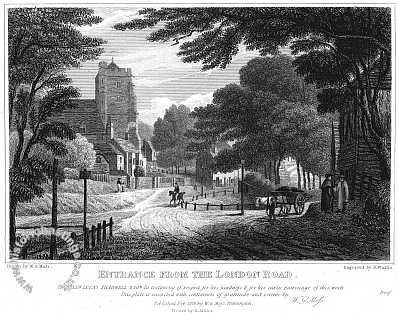
“Entrance from the London Road” in 1824 this was the main road to Battle and London. The modern London Road starts in St Leonards which is yet to be built.
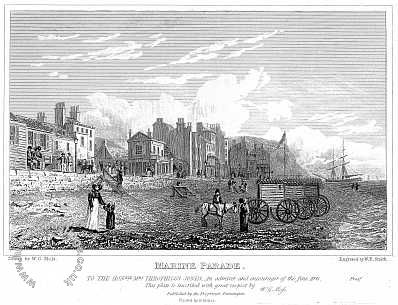
“Marine Parade” Powell’s library is almost in the centre of the picture with the battery or Fort on its right, nowadays the whole beach area in the picture is covered with the A259 Coast Road
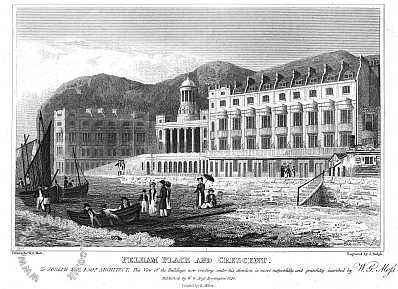
“Pelham Place and Crescent” compare this with “Pelham Place”, the Crescent hasn’t yet been built and Moss had to rely on descriptions given to him of what it would look like. The beach area in the picture is now completely covered with the A259 and the Pelham car park.
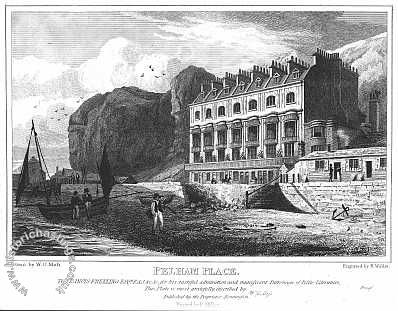
“Pelham Place” before Pelham Crescent, Castle Street and Breeds Place were built. The Cliff on the left, known as the Gun Garden and was cut away in 1823 to allow the development.
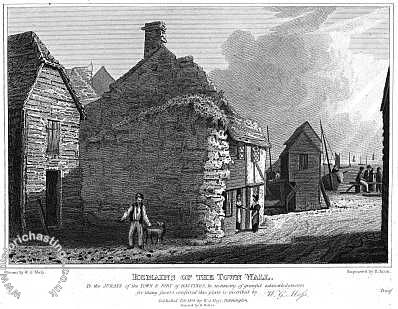
“Remains of the Town Wall” today the continuation of this wall can be seen behind the Royal Standard pub. The end of the wall in this view is still there, rendered over and just to the right of the front of the Lord Nelson.
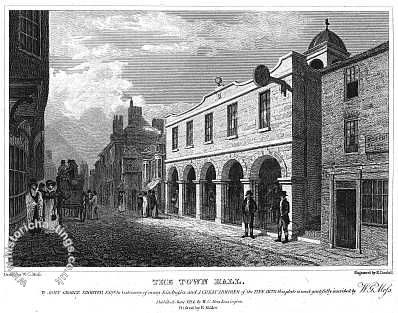
“The Town Hall” the foundation stone was laid in 1823 and the ground floor was initially a market, later becoming a police station and fire station. The town hall in Queens Road replaced it in 1881 and in 1949 it became the now threatened Museum of Local History.
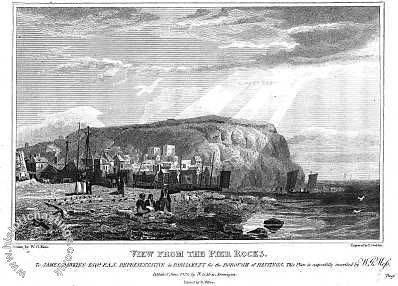
“View from the Pier Rocks” these rocks were in front of the battery or Fort and are now covered by the Coast Road and the buildup of beach
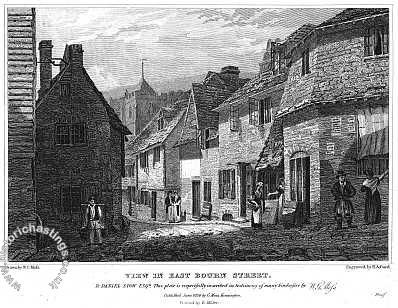
“View in East Bourne Street” often mistaken for Courthouse Street the eastern end of the street where it exits onto High Street corresponds roughly Post Office passage